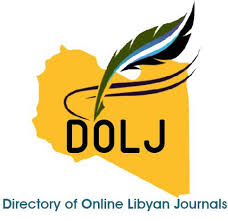Lung Function Parameters in Healthy Libyan Children and Adolescents aged between 4 - 19 years
DOI:
https://doi.org/10.54361/Keywords:
lung function tests, Expiratory flow-volume curvesAbstract
Background: No appropriate reference values of lung function parameters exist in healthy Libyan children with which the same parameters of pediatric respiratory patients of this country can be compared. Our aim; to asses lung function parameters in Libyan healthy children to use in assessment of lung function abnormalities in children with respiratory disease. Methods: Spirometeric values were measured in a group of 449 healthy Libyan children and adolescents (226 boys and 223 girls), aged between 4-19 years old. Multiple linear analysis was performed for each spirometric parameter against age, weight, height and BMI. Results: The values of the measured parameters increased nonlinearly and correlated significantly with body height (P 0.05); the correlation was much lower with age. The best- fit regression equation relating the measured parameters values and body height was a simple power function providing the possibility to calculate the mean value with lower and upper limits for each parameter. No statistical significant differences of the studied functional parameters were found between boys and girls. Conclusions: our reference values are close to those of the European children. These developed predictive values can be used in clinical practice in Libya and in other neighboring North African countries.
Downloads
References
American Thoracic Society. Lung function testing: selection of reference values and interpretative strategies. Am Rev Respir Dis. 1991; 144: 1202–1218
Cotes JE. Lung Function. Assessment and Application in Medicine. Blackwell Scientific Publications, Oxford, 4th Ed. 1979.
Dufetel P, Wazni A, Gaultier C, Derossi G, Cisse F, Martineaud JP. Growth and ventilatory function in Black children and adolescents. Rev Mal Respir 1995; 12: 135- 143.
McKenzie SA, Chan E, Dundas I, Bridge PD, Pao CS, Mylonopoulu M, Healy MJ. Airway resistance measured by the interrupter technique: normative data from 2-10 year olds of three ethnicities. Arch Dis Child 2002; 87:248-251.
Ip MS, Karlberg EM, Karlberg JP, Luk KD, Leong JC. Lung function reference values in Chinese children and adolescents in Hong Kong. I. Spirometric values and comparisons with other populations. Am J Respir Crit Care Med 2000; 162:424-429.
Harik-Khan RI, Muller DC, Wise RA. Racial difference in lung function in African- American and White children: effects of anthropometric, socioeconomic, nutritional, and environmental factors. Am J Epidemiol 2004; 160: 893-900.
Rosenthal M, Bain SH, Cramer D, Helms P, Denison P, Bush A, Warner JO. Lung function in white children aged 4 to 19 years: I-Spirometry. Thorax 1993; 48: 794-802.
Wang X, Dockery DW, Wypij D, Fay ME, Ferris BG Jr. Pulmonary function between 6 and 18 years of age. Pediatr Pulmonol 1993; 15: 75-88.
Stocks J, Gappa M, Rabbette PS, Hoo AF, Mukhtar Z, Costeloe KL. A comparison of respiratory function in Afro-Caribbean and Caucasian infants. Eur Respir J 1994; 7: 11- 16.
Sylvester KP, Milligan P, Patey RA, Rafferty GF, Greenough A. Lung volumes in healthy Afro-Caribbean children aged 4-17 years. Pediatr Pulmonol 2005; 40: 109-112.
Trabelsi Y, Ben Saad H, Tabka Z, Gharbi N, Bouchez Buvry A, Richalet JP, Guenard H. Spirometric reference values in Tunisian children. Respiration 2004; 71: 511-518.
Al-Riyami BM, Al-Rawas OA, Hassan MO. Normal spirometric reference values for Omani children and adolescents. Respirology 2004; 9: 387-391.
Graff-Lonnevig V, Harfi H, Tipirneni P. Peak expiratory flow rates in healthy Saudi Arabian children living in Riyadth. Ann Allergy 1993; 71: 446-450.
Al- Dawood K. Peak expiratory flow rate in Saudi schoolboys at Al-Khobar City, Saudi Arabia. Saudi Med J 2000; 21: 561-564.
Lawlor, D.A., Ebrahim, S., and Davey Smith, G. Association between self-reported childhood socioeconomic position and adult lung function: findings from the British Women's Heart and Health study. Thorax. 2004; 59: 199–203
American Thoracic Society. Lung function testing: selection of reference values and interpretative strategies. Amer Rev Respir Dis 1991; 144: 1202-1218.
Shamssain MH, Thompson J, Ogston SA. Forced expiratory indices in normal Libyan children aged 6-19 years. Thorax 1988; 43: 467-470.
Zapletal A, Chalupová J. Forced expiratory parameters in healthy preschool children (3- 6 years of age). Pediatr Pulmonol 2003; 35: 200-207.
Zapletal A, Šamánek M, Paul T. Lung function in children and adolescents. Methods, reference values. Prog Respir Res 1987; 22: 1-220.
Zapletal A, Rydlová J, Hak J. Dry powder long acting bronchodilators in asthmatic children and adolescents. Alergie 2002; 4: 285-290.
Zapletal A, Motoyama EK, van de Woestijne KP Hunt VR, Bouhuys A. Maximum expiratory flow-volume curves and airway conductance in children and adolescents. J Appl Physiol 1969; 26: 308-316.
Zapletal A, Šamánek M, Paul T. Upstream and total airway conductance in children and adolescents. Bull Eur Physio-Path Resp 1982; 18: 31-37.
Downloads
Published
Issue
Section
License
Copyright (c) 2018 Faraj Abdussalam , Adel Gritli, Millad Ghawil, Suad Elmeddah, Ali Mgadmi, Alois Zapletal (Author)

This work is licensed under a Creative Commons Attribution-NonCommercial-NoDerivatives 4.0 International License.
Open Access Policy
Libyan journal of medical Research (LJMR).is an open journal, therefore there are no fees required for downloading any publication from the journal website by authors, readers, and institution.
The journal applies the license of CC BY (a Creative Commons Attribution 4.0 International license). This license allows authors to keep ownership f the copyright of their papers. But this license permits any user to download , print out, extract, reuse, archive, and distribute the article, so long as appropriate credit is given to the authors and the source of the work.
The license ensures that the article will be available as widely as possible and that the article can be included in any scientific archive.
Editorial Policy
The publication of an article in a peer reviewed journal is an essential model for Libyan journal of medical Research (LJMR). It is necessary to agree upon standards of expected ethical behavior for all parties involved in the act of publishing: the author, the journal editorial, the peer reviewer and the publisher.
Any manuscript or substantial parts of it, submitted to the journal must not be under consideration by any other journal. In general, the manuscript should not have already been published in any journal or other citable form, although it may have been deposited on a preprint server. Authors are required to ensure that no material submitted as part of a manuscript infringes existing copyrights, or the rights of a third party.
Authorship Policy
The manuscript authorship should be limited to those who have made a significant contribution and intellectual input to the research submitted to the journal, including design, performance, interpretation of the reported study, and writing the manuscript. All those who have made significant contributions should be listed as co-authors.
Others who have participated in certain substantive aspects of the manuscript but without intellectual input should only be recognized in the acknowledgements section of the manuscript. Also, one of the authors should be selected as the corresponding author to communicate with the journal and approve the final version of the manuscript for publication in the LJMR.
Peer-review Policy
- All the manuscripts submitted to LJMR will be subjected to the double-blinded peer-review process;
- The manuscript will be reviewed by two suitable experts in the respective subject area.
- Reports of all the reviewers will be considered while deciding on acceptance/revision or rejection of a manuscript.
- Editor-In-Chief will make the final decision, based on the reviewer’s comments.
- Editor-In-Chief can ask one or more advisory board members for their suggestions upon a manuscript, before making the final decision.
- Associate editor and review editors provide administrative support to maintain the integrity of the peer-review process.
- In case, authors challenge the editor’s negative decision with suitable arguments, the manuscript can be sent to one more reviewer and the final decision will be made based upon his recommendations.











